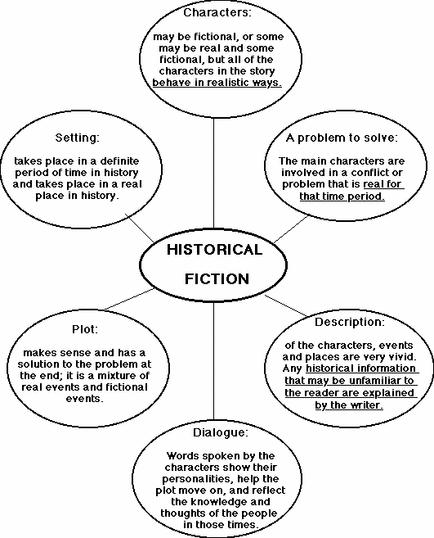The Genre of Historical Fiction

In our research, we were surprised to learn that different people and organizations have different definitions for what constitutes historical fiction. Historical fiction seems to be stories or novels set within historical periods where the characters refer and/or respond realistically to the actual historical events of that period. Some or all of the characters are fictitious, while some characters really lived during the period in which the story is set. In many examples, the actual events of the period drive a substantial portion of the plot or motivate the thoughts and actions of the characters. Below is a flow chart that we located that outlines fairly well these defining components. This flow chart and other information about the genre of historical fiction can be found at the following site: http://www.k12.hi.us/~gfujimur/eschool/historical_fiction/characteristics.htm
Why Moon Over Manifest Falls Within the Genre of Historical Fiction
*The story is set in a fictiously named town that is based upon a real small town in Kansas.
*The story, set in 1936, makes references to the Great Depression and depicts the town and characters in a way consistent with the Great Depression.
*The story within the story is set in 1918. Ned joins to fight in World War I and through letters, we learn about his experiences as a soldier fighting in France and about trench warfare.
*Most of the residents of Manifest are immigrants from other countries. Some of them express their experiences of coming to the United States by way of Ellis Island. Socially and culturally, the town is divided on the basis of national heritage.
*The town, like most towns across America in 1918, was struck by the 1918 Spanish Influenza pandemic.
*Character names, perspectives, ideas, experiences, language, feelings, and actions are motivated by events in the story that actually happened in 1936 (The Great Depression), 1918 (World War I and The Spanish Influenza), and the late 19th Century to early 20th Century (Immigration from Europe via Ellis Island).
*The story, set in 1936, makes references to the Great Depression and depicts the town and characters in a way consistent with the Great Depression.
*The story within the story is set in 1918. Ned joins to fight in World War I and through letters, we learn about his experiences as a soldier fighting in France and about trench warfare.
*Most of the residents of Manifest are immigrants from other countries. Some of them express their experiences of coming to the United States by way of Ellis Island. Socially and culturally, the town is divided on the basis of national heritage.
*The town, like most towns across America in 1918, was struck by the 1918 Spanish Influenza pandemic.
*Character names, perspectives, ideas, experiences, language, feelings, and actions are motivated by events in the story that actually happened in 1936 (The Great Depression), 1918 (World War I and The Spanish Influenza), and the late 19th Century to early 20th Century (Immigration from Europe via Ellis Island).
